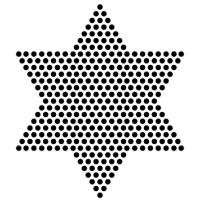Puzzles
4 December
Today's number is a three digit number which is equal to the sum of the cubes of its digits. One less than today's number also has this property.
Show answer
Hide answer
If the final digit of the number is 0, then some carrying takes place when 1 is subtracted. Otherwise, no carrying happens.
If no carrying happens, call the three digits of today's number \(A\), \(B\), and \(C\). We know that \(A^3+B^3+C^3\) is one more than \(A^3 + B^3 + (C-1)^3\).
This implies that \(C^3=(C-1)^3+1\), which is only possible if \(C\) is 1.
Therefore either the final digit of today's number is 0 or the final digt of one less that today's number is 0. In both cases, we need to find a number
with the desired property whose final digit is 0: we are looking for digit \(A\) and \(B\) such that \(A^3+B^3\) is a multiple of 10.
Looking at all the cube numbers, there are a few combinations that add up to multiple of 10:
$$0^3+0^3=0$$
$$1^3+9^3=730$$
$$2^3+8^3=520$$
$$3^3+7^3=370$$
$$4^3+6^3=280$$
$$5^3+5^3=250$$
The only one of these that has the required property is 370. By checking 369 and finding it doesn't have the property, we see that the two numbers must be
370 and 371.
Square and cube endings
Source: UKMT 2011 Senior Kangaroo
How many positive two-digit numbers are there whose square and cube both end in the same digit?
Show answer & extension
Hide answer & extension
Only the units digit of the number will affect the last digit of the square and cube. This table shows how the last digits of the square and cube depend on the last digit of the number:
| Last digit of... |
| number | square | cube |
| 0 | 0 | 0 |
| 1 | 1 | 1 |
| 2 | 4 | 8 |
| 3 | 9 | 7 |
| 4 | 6 | 4 |
| 5 | 5 | 5 |
| 6 | 6 | 6 |
| 7 | 9 | 3 |
| 8 | 4 | 2 |
| 9 | 1 | 9 |
So numbers ending in 0, 1, 5 and 6 will have squares and cubes that end in the same digit. There are 4×9=36 two-digit numbers then end in one of these digits.
Extension
How many two-digit numbers are there in binary whose square and cube end in the same digit?
How many two-digit numbers are there in ternary whose square and cube end in the same digit?
How many two-digit numbers are there in base \(n\) whose square and cube end in the same digit?
What's the star?
In the Christmas tree below, the rectangle, baubles, and the star at the top each contain a number. The square baubles contain square numbers; the triangle baubles contain triangle numbers; and the cube bauble contains a cube number.
The numbers in the rectangles (and the star) are equal to the sum of the numbers below them. For example, if the following numbers are filled in:
then you can deduce the following:
What is the number in the star at the top of this tree?
You can download a printable pdf of this puzzle here. Show answer
Hide answer
The two numbers between 14 are a cube number and a triangle number: these must be 8 and 6. Next you can see that 23 is the sum of 8, two times a triangle number and a square number: the triangle and square numbers must be 3 and 9.
Next, call the square number at the bottom left \(a\), the square number at the top left \(b\), and the triangle number at the top right \(c\). Adding upwards, we find that \(a+b+45=106\) and \(a+141+c=198\); and so \(a+b=61\) and \(a+c=57\). The only two square numbers that add to 61 are 25 and 36. Therefore \(c\) must be 21 or 32, but must be 21 as 32 is not a triangle number. And so \(a\) is 36 and \(b\) is 25.
Putting all these numbers into the tree gives the top number as
433. This is fitting because 433 is in fact a
star number:






